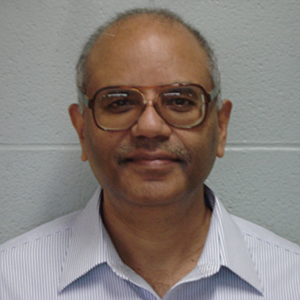Directory
Rajiv Berry
Adjunct Professor
Adjunct
School of Engineering: Department of Chemical and Materials Engineering
Selected Publications
- Emami, F.S., V. Puddu, R.J. Berry, V. Varshney, S.V. Patwardhan, C.C. Perry, and H. Heinz. 2014. Prediction of specific biomolecule adsorption on silica surfaces as a function of pH and particle size. Chemistry of Materials 26, no. 19: 5725-5734.
- Sheikholeslami, S., R.B. Pandey, N. Dragneva, W. Floriano, O. Rubel, S.A. Barr, Z. Kuang, R. Berry, R. Naik, and B. Farmer. 2014. Binding of solvated peptide (EPLQLKM) with a graphene sheet via simulated coarse-grained approach. Journal of Chemical Physics 140, no. 20: 204901/1-204901/8.
- Emami, F.S., V. Puddu, R.J. Berry, V. Varshney, S.V. Patwardhan, C.C. Perry, and H. Heinz. 2014. Force field and a surface model database for silica to simulate interfacial properties in atomic resolution. Chemistry of Materials 26, no. 8: 2647-2658.
- Camden, A.N., S.A. Barr, and R.J. Berry. 2013. Simulations of peptide-graphene interactions in explicit water. Journal of Physical Chemistry B 117, no. 37: 10691-10697.
- Moller, J.C., S.A. Barr, E.J. Schultz, T.D. Breitzman, and R.J. Berry. 2013. Simulation of fracture nucleation in cross-linked polymer networks. JOM 65, no. 2: 147-167.
- Patwardhan, S.V., F.S. Emami, R.J. Berry, S.E. Jones, R.R. Naik, O. Deschaume, H. Heinz, and C.C. Perry. 2012. Chemistry of aqueous silica nanoparticle surfaces and the mechanism of selective peptide adsorption. Journal of the American Chemical Society 134, no. 14: 6244-6256.
- Feng, J.; R.B. Pandey, R.J. Berry, B.L. Farmer, R.R. Naik, and H. Heinz. 2011. Adsorption mechanism of single amino acid and surfactant molecules to Au {111} surfaces in aqueous solution: Design rules for metal-binding molecules. Soft Matter 7, no. 5: 2113-2120.
- Jacobs, J.D., M.J. Arlen, D.H. Wang, Z. Ounaies, R.J. Berry, L.S. Tan, P.H. Garrett, and R.A. Vaia. 2010. Dielectric characteristics of polyimide CP2. Polymer 51, no. 14: 3139-3146.
- Schwartz, M., R.J. Berry, D.S. Dudis, and A.T. Yeates. 2008. Effects of substituents on the electronic properties of polyacetylenes. Journal of Molecular Structure: THEOCHEM 859, no. 1-3: 37-45.
- Berry, R.J., D. Rigby, D. Duan, and M. Schwartz. 2006. Molecular dynamics study of translational and rotational diffusion in liquid ortho-terphenyl. Journal of Physical Chemistry A 110, no. 1: 13-19.
- Schwartz, M., D. Duan, and R.J. Berry. 2005. Molecular dynamics study of anisotropic translational and rotational diffusion in liquid benzene. Journal of Physical Chemistry A 109, no. 38: 8637-8641.
- Schwartz, M., G.N. Srinivas, A.T. Yeates, R.J. Berry, and D.S. Dudis. 2004. The electronic properties of polyacetylene-polymethineimine block copolymers. Synthetic Metals 143, no. 2: 229-236.
- Yang, S.H., and R.J. Berry. 2003. Molecular dynamics simulation of germanium nanoparticles. Materials Research Society Symposium Proceedings 769: 201-206.
- Schwartz, M., A.N. Davis, A.T. Yeates, R.J. Berry, and D.S. Dudis. The electronic structure and properties of pristine and protonated 1-azapolyacetylenes. Journal of Molecular Structure: THEOCHEM 629: 285-293.
- Schwartz, M., L.R. Peebles, R.J. Berry, and P. Marshall. 2003. A computational study of chlorofluoro-methyl radicals. Journal of Chemical Physics 118, no. 2: 557-564.
- Ewig, C.S., R.J. Berry, U. Dinur, J.R. Hill, M.J. Hwang, H. Li, C. Liang, J. Maple, Z. Peng, and T.P. Stockfisch. 2001. Derivation of class II force fields. VIII. Derivation of a general quantum mechanical force field for organic compounds. Journal of Computational Chemistry 22, no. 15: 1782-1800.
- Bharadwaj, R.K., R.J. Berry, and B.L. Farmer. 2001. Molecular dynamics simulation study of polysilane and polysilaethylene. Polymeric Materials Science and Engineering 85: 408-409.
- Berry, R.J., N.L. Wintrich, R.K. Bharadwaj, and M. Schwartz. 2001. Computational nanotribology: SAMs for MEMS. Materials Research Society Symposium Proceedings 649: Q9.5.1-Q9.5.6.
- Schwartz, M., and R.J. Berry. 2001. Ab initio investigation of substituent effects on bond dissociation enthalpies in siloxanes and silanols. Journal of Molecular Structure: THEOCHEM 538: 9-17.
- Bharadwaj, R.K., R.J. Berry, and B.L. Farmer. 2000. Molecular dynamics simulation study of norbornene-POSS polymers. Polymer 41, no. 19: 7209-7221.
- Yamada, T., T.D. Fang, P.H. Taylor, and R.J. Berry. 2000. Kinetics and thermochemistry of the OH radical reaction with CF3CCl2H and CF3CFClH. Journal of Physical Chemistry A 104, no. 21: 5013-5022.
- Waltman, R.J., G.W. Tyndall, J. Pacansky, and R.J. Berry. 2000. Impact of polymer structure and confinement on the kinetics of Zdol 4000 bonding to amorphous-hydrogenated carbon. Tribology Letters 7: 91-102.
- Berry, R.J., A.L. Wilson, and M. Schwartz. 2000. A computational study of bond dissociation enthalpies and hydrogen abstraction energy barriers in model urethanes. Journal of Molecular Structure: THEOCHEM 496, no. 1-3: 121-129.
Courses Taught
- Computational Chemistry
Degrees
- Ph.D. Chemistry, University of South Carolina, 1986
- M.S. Chemistry, University of Missouri, 1981
- M.S. Chemistry (five-year degree included undergrad), Indian Institute of Technology, Delhi, 1979
Professional Activities
- American Chemical Society
Research Interests
Research relates to current and prospective interests in the design of improved materials for aerospace applications. Methods include electronic structure theory (e.g. DFT under 3-D PBC), chemical kinetics modeling, and molecular dynamics (including coarse-grained MD). Areas of interest include computation of transport properties (diffusion, electrochemical characteristics) and physical properties (glass transition, fragility, and density), elucidation of reaction pathways, prediction of interfacial phenomena, and calculation of mechanical properties. Projects of interest are described below:
- Molecular dynamics simulations to investigate surface interactions of bio-inspired materials.
- MD simulations to evaluate the modulus, strength, and fracture toughness of polymer nanocomposites.
- Coarse-grained MD simulations to characterize physical aging in neat hairy nanoparticle systems.
- Simulations to characterize the morphology and electrochemical properties of organic photovoltaics.
